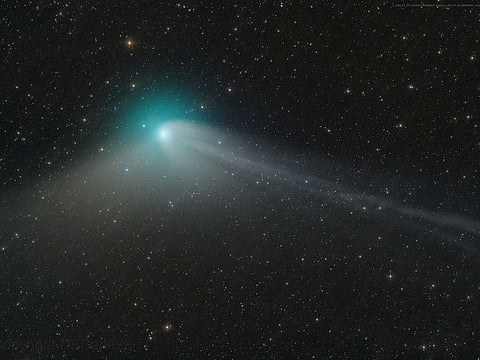How to see the green comet: The astronomer who discovered it explains
The comet known as 'Comet C/2022 E3' is made up of complex carbon chain molecules

An extraordinary green comet that hasn't appeared in Earth's night skies since the time of woolly mammoths will make its closest approach Wednesday and Thursday.
Scientists have calculated the orbital period of the comet, known as Comet C/2022 E3, as 50,000 years. That means Neanderthals walked the land the last time it came around - and after it passes Earth this time and returns to deep space, it won't be seen again by any person currently living.
This week, the comet could be visible to the unaided eye in areas with minimal light pollution - but experts suggest using a pair of binoculars or a telescope for the best look. Although we'll be able to see it, don't be fooled, the comet will pass our planet from 28 million miles away.
Discovery of the rare comet
The rare comet was discovered by astronomers Bryce Bolin and Frank Masci using what's called the Zwicky Transient Facility telescope (ZTF) at the Palomar Observatory in California. In a recent interview, Bolin spoke about the comet's discovery, its rarity and the best ways to view it.
It was a little before midnight on the second day of March last year when Bolin hopped on his walking desk and activated a system to detect comets. He took a deep look into space using the Zwicky Transient Facility, an old circus-cannon-shaped telescope that takes hundreds of deep-space pictures per night. This was a nightly ritual, but on this clear-sky night, he would find something that he - or any living human - had never seen before.
After hours of analysing data outputs, the system he created to find comets in images flagged a set of five photos. It noted an 85 per cent probability that it had identified a comet.
Even with a system that uses artificial intelligence, Bolin said that it's him "as a human being that has the final say."
Still, Bolin wasn't sure whether it was a comet or an asteroid.
"I wanted to say that it could be a comet, but I am always very careful before I make an official announcement," he said.
He sent an alert to the Minor Planet Center at the International Astronomical Union and requested a spare telescope to double check. Within days, other observers confirmed that they saw a "coma," which is a combination of gas and dust formed around the comet's head, indicating that it was a comet.
"A week later, we announced the discovery of the comet," Bolin said.
On Wednesday, "you can find the comet by looking south of the Big Dipper, near the constellation Camelopardalis," Bolin said. "If you can find the North Star, you can then trace directly south of that to that."
The glowing green nucleus and near-nucleus coma of the comet will appear to look "wide" and be "half of the size of a full moon," according to Bolin.
Chance to see the spectacle
Skywatchers don't have to worry about missing the comet because it will be travelling very slowly. "It will be hard to see it move," he said.
For the first half of February, the comet will be visible by a "vast majority of the Northern Hemisphere and in the north direction," according to Bolin.
By February 7 and 8, the glowing green globe will be near Mars.
The comet will then travel south and hover over the equator by the middle of the month, giving people who live near in those latitudes a chance to see the spectacle.
The comet is made up of complex carbon chain molecules that get destroyed by the sun's light and broken down into simpler carbon diatomic molecules. That causes the green aura, Bolin said.
These comets are like "prehistoric relics" because they were formed in the very early history of the solar system, Bolin said. This particular one, Comet C/2022 E3, comes from the outermost reaches of space, Bolin said.
Long-period comets, like this one, first brought organic compounds to Earth when they hit the planet 4 billion years ago. It is because of these comets that "Earth has its abundant life," Bolin said.
"We know that it has to be kind of like a time capsule of the conditions in the solar system around the time of its birth," Bolin said. "So it kind of preserves like a record, legacy of the solar system and the kinds of chemical compounds and even the precursors of life."
"These kinds of comets that come this close or become this bright only come every few years or so, every four or five years," Bolin said.
Bolin explained that improved technology in the past decade has allowed for more comets to be discovered. The last observed comet was Lovejoy, discovered in 2011, he said.
"But since then, there hasn't been anything like this comet that approaches this level of brightness," he said.
A year before C/2022 E3 was discovered, Bolin discovered another, on nearly the same date: The C/2021 E3.
"The fact that Comet 2022 is named E3 and Comet 2021 is named E3 means that they were around roughly the same calendar date," Bolin said.
The previous comet was discovered on March 9, 2021, but it didn't generate a lot of interest in the scientific community because it didn't come close enough to Earth to be observed.
"It's like [C/2022 E3's] less famous sibling," Bolin said.
Sign up for the Daily Briefing
Get the latest news and updates straight to your inbox



